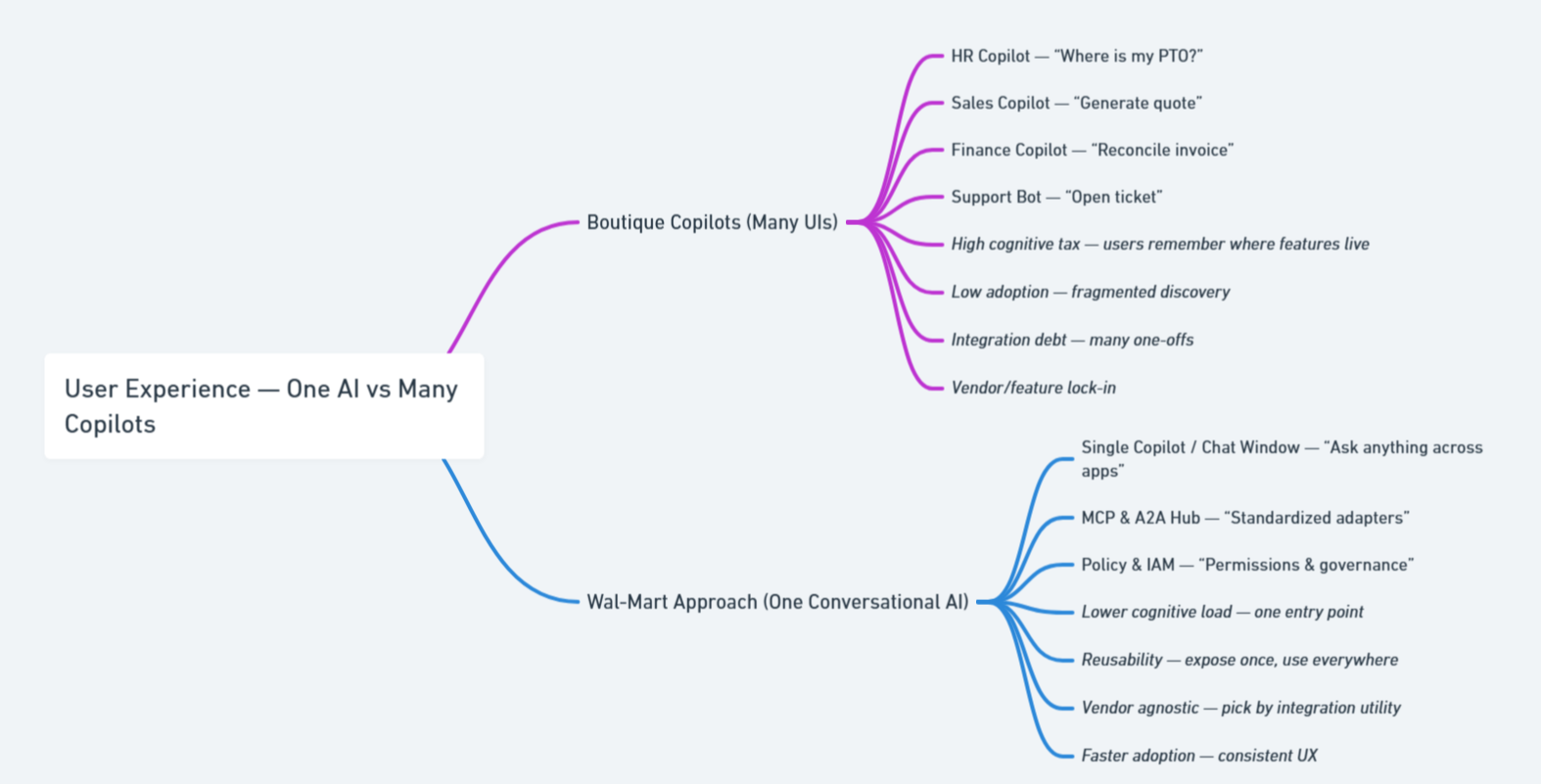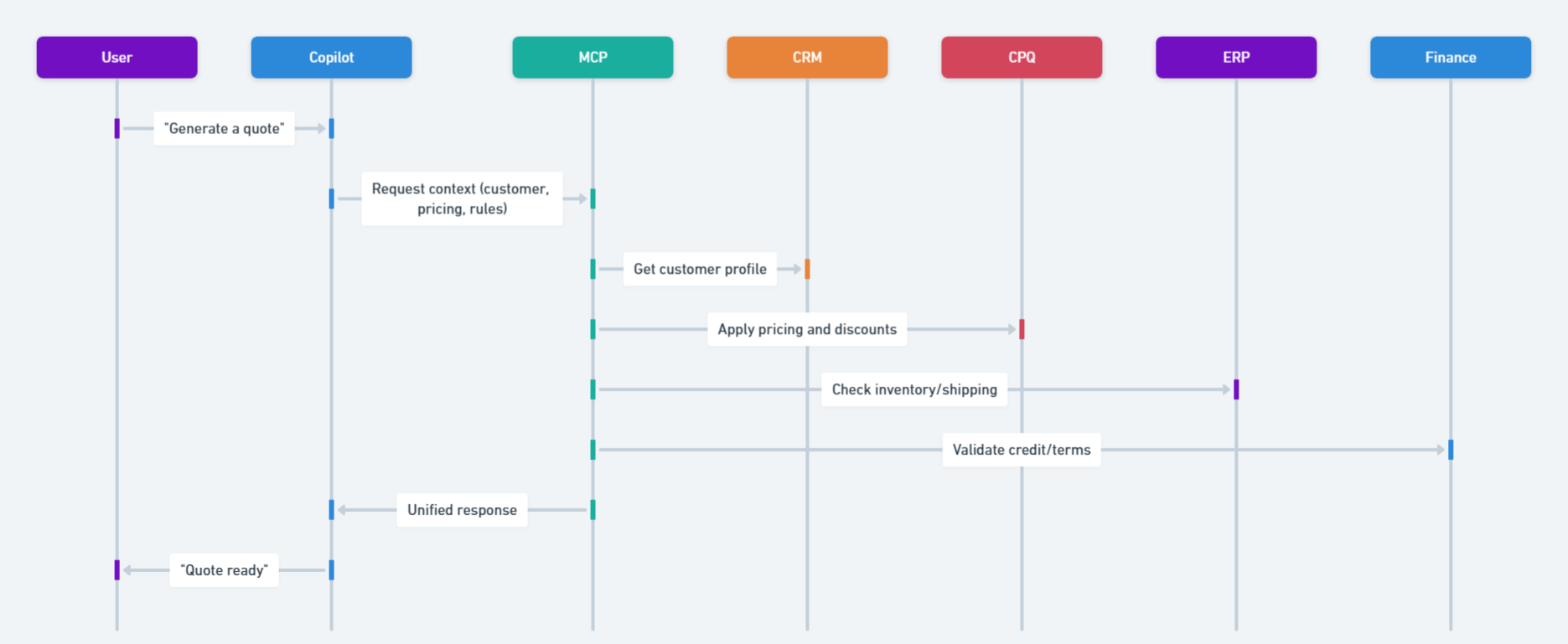MCP + A2A- Why Enterprise AI Needs Wal-Mart, Not Boutiques
Reading Time: 6 mins
Quick Context
- What? A technical roadmap for building unified AI experiences using emerging integration protocols.
- Who? CIOs, CTOs, enterprise architects, and technical leaders planning AI architecture strategy.
- Why? Because users want one AI interface, not ten boutique copilots scattered across your portfolio.
→ The Wal-Mart of AI is built on MCP and A2A standards that unify fragmented experiences.
What can you do with it?
- Evaluate integration protocols (MCP & A2A readiness for your app portfolio)
- Plan architecture evolution (applications consumable as AI tools, not siloed UIs)
- Guide implementation strategy (focus on protocol adoption vs. interface proliferation)
- Future-proof vendor decisions (integration capability > feature checklists)
The Core Challenge
You don’t visit ten specialty stores to cook dinner—you go to one supermarket. Your users feel the same about AI.
They don’t want to remember which of your 200+ apps has the “quote copilot” or the “HR chatbot.” The cognitive tax is killing adoption. The answer isn’t more AI interfaces—it’s better integration through protocols like MCP (Model Context Protocol) and A2A (Application-to-Application) standards.

The Three Shifts Reshaping AI Architecture
1. People: From Clicks to Chat
Users expect to ask questions, not navigate menus. Conversational protocols make applications consumable by AI copilots instead of forcing users through traditional UIs.
2. Process: From Silos to Symphony
AI is now the arbiter of information, integrating structured + unstructured data across CRMs, ERPs, docs, and video. The winning move: protocol alignment, not vendor lock-in.
3. Technology: From Partner to Plumbing
Vendors are shifting from “strategic partner” to operational plumbing. Apps will be judged not by features, but by protocol compatibility and ease of orchestration.
The MCP Solution: Model Context Protocol
What MCP Does
MCP defines how models consume context (tools, data sources, APIs) in a standardized way. Instead of hard-wiring every app into every copilot, MCP exposes resources once—then any AI agent can call them.
Implementation Roadmap
- Audit your apps for API endpoints and function granularity
- Wrap them in MCP-compliant interfaces (adapters where needed)
- Register MCP resources in your enterprise AI layer (copilot, agent, or orchestrator)
- Validate security/authN/authZ with existing IAM
- Scale across portfolio with governance
Enterprise Considerations
- Security: Standardized permissioning and context control
- Scalability: Resource discovery and orchestration at scale
- Vendor Ecosystem: Adoption is accelerating (OpenAI, Anthropic, LangChain, Microsoft)
The A2A Evolution: Application-to-Application Standards
Architecture Patterns
A2A protocols define how applications talk to each other when orchestrated by AI. Think of it as the “grammar” of enterprise AI conversations.
Building A2A-Ready Apps
- Design APIs that expose business functions, not just CRUD endpoints
- Keep functions granular (e.g.,
calculate_discount, not justupdate_quote) - Implement predictable contracts and error handling
Implementation Strategy
- Start with core business flows (e.g., quote-to-cash, ticket resolution)
- Pilot cross-app orchestration with 2–3 systems
- Expand to ecosystem apps with adapter layers for legacy systems
Real-World Example: Quote-to-Cash Flow
A sales rep asks their copilot: “Generate a customer quote with current pricing and delivery dates.”

Behind the scenes:
- Salesforce CRM: Customer profile + history
- CPQ: Configurations, discounts, pricing
- SAP ERP: Inventory + shipping
- Finance System: Credit check + contract terms
MCP standardizes model access to these resources. A2A orchestrates the backend calls. The rep sees one conversational experience, not four disconnected apps.
Technical Architecture Playbook
Protocol Readiness Assessment
- Audit APIs for MCP/A2A compatibility
- Map data + process bottlenecks
- Review security models
Implementation Priorities
- Start with daily-use, high-value apps
- Target process-heavy workflows where integration pays off
- Use protocol adapters for legacy systems
- Establish governance for cross-app AI traffic
Vendor Evaluation Criteria
- Native protocol support vs. custom adapters
- Function granularity + orchestration readiness
- Security model alignment with enterprise IAM
- Roadmap commitment to MCP/A2A
Strategic Implications
- For IT Leaders: Stop buying copilots in isolation. Start building an AI-consumable ecosystem.
- For Architects: Treat AI integration as a first-class design principle. Retrofit apps with adapters where needed.
- For Business Leaders: Value vendors by integration utility, not shiny features that create silos.
Implementation Roadmap
-
Phase 1: Assessment (30–60 days)
Inventory applications, map opportunities, evaluate vendor support. -
Phase 2: Pilot (60–90 days)
Apply MCP/A2A to 2–3 high-impact apps, test workflows, validate security. -
Phase 3: Scale (6–12 months)
Roll out across portfolio, establish governance, train teams.
TL;DR
The Wal-Mart approach to enterprise AI isn’t about consolidating vendors—it’s about protocol adoption that unifies user experiences.
MCP + A2A let you:
- Orchestrate existing apps behind a single conversational interface
- Keep current investments while future-proofing architecture
- Reduce cognitive tax for users by making AI the one stop shop
Immediate Next Steps
- Inventory apps for MCP/A2A readiness
- Identify 2–3 pilot flows
- Make integration capability your top vendor criterion
What's Next?
👉 What's your current approach to AI integration protocols? Are you hitting the same roadblocks?
The future of enterprise AI isn't about choosing between vendors—it's about choosing protocols that enable seamless orchestration. MCP and A2A represent the foundational standards that will determine which applications thrive in the AI-first enterprise.
Key Takeaways:
- Unified Experience: One conversational interface instead of multiple siloed copilots
- Protocol-First: Integration capability trumps feature checklists when evaluating vendors
- Future-Proof Architecture: MCP and A2A ensure your investments remain relevant as AI evolves
- Reduced Cognitive Load: Users get answers, not navigation instructions
Ready to transform your enterprise AI strategy?
- Book a Demo to see GPTfy's secure AI integration in action
- Calculate Your Salesforce + AI ROI to quantify potential time and cost savings
- Check out GPTfy Website
- See more Salesforce + AI Use Cases
